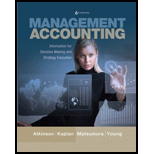
Concept explainers
Explain the reason for traditional volume-based cost allocation system that is likely to systematically distort product costs.
Explanation of Solution
Product costs: The costs incurred to acquire the merchandise, ship the stock, prepare the merchandise for sale, and store the inventory are collectively referred to as product costs or inventory costs. Purchase price of merchandise, transportation costs, conversion costs, storage costs are some examples of product costs.
Traditional volume based cost allocation system focus only on volume of production and not on activities required to be performed in producing various products that is direct labor dollars, direct labor hours, or machine hours. These are likely to systematically misrepresent product costs because they break relation between the cause and assigning for the cost to the individual products.
Examples for batch related activities are as follows:
- Set ups.
- Changeovers.
- Inspecting the first item of production run.
Examples for number of product are as follows:
- Scheduling materials receipts.
- Improving products.
On the other hand cost distortions tend to have great change between relative proportions of indirect resources which is used by cost objects. It reflects greater differences because traditional cost assignment regarding volume-related measures doesn’t reflect the differences between relative proportions (of indirect resources).
Want to see more full solutions like this?
Chapter 5 Solutions
Management Accounting
- Explain In the context of accounting, "liquidity" refers to:a) The amount of cash a business hasb) The ability to pay short-term obligations as they come duec) The net income of a businessd) The profitability of a businessarrow_forwardWhich financial statement shows the financial position of a company on a specific date?a) Income Statementb) Statement of Cash Flowsc) Balance Sheetd) Statement of Retained Earningsarrow_forwardIn the context of accounting, "liquidity" refers to:a) The amount of cash a business hasb) The ability to pay short-term obligations as they come duec) The net income of a businessd) The profitability of a businessarrow_forward
- What is the double-entry system of accounting?a) Recording each transaction twiceb) Maintaining two sets of books for the same businessc) A system that records both the giving and receiving aspects of a transactiond) A system used only for large organizationsarrow_forwardI need guidance with this financial accounting problem using the right financial principles.arrow_forwardWhat is the managerial accounting ? give in detailsarrow_forward
- Can you explain this financial accounting question using accurate calculation methods?arrow_forwardI am searching for the accurate solution to this financial accounting problem with the right approach.arrow_forwardWhich of the following is considered a current asset?a) Landb) Inventoryc) Equipmentd) Goodwillarrow_forward
- I am searching for the accurate solution to this general accounting problem with the right approach.arrow_forwardCan you explain the correct approach to solve this general accounting question?arrow_forwardCan you help me solve this general accounting question using valid accounting techniques?arrow_forward

 AccountingAccountingISBN:9781337272094Author:WARREN, Carl S., Reeve, James M., Duchac, Jonathan E.Publisher:Cengage Learning,
AccountingAccountingISBN:9781337272094Author:WARREN, Carl S., Reeve, James M., Duchac, Jonathan E.Publisher:Cengage Learning, Accounting Information SystemsAccountingISBN:9781337619202Author:Hall, James A.Publisher:Cengage Learning,
Accounting Information SystemsAccountingISBN:9781337619202Author:Hall, James A.Publisher:Cengage Learning, Horngren's Cost Accounting: A Managerial Emphasis...AccountingISBN:9780134475585Author:Srikant M. Datar, Madhav V. RajanPublisher:PEARSON
Horngren's Cost Accounting: A Managerial Emphasis...AccountingISBN:9780134475585Author:Srikant M. Datar, Madhav V. RajanPublisher:PEARSON Intermediate AccountingAccountingISBN:9781259722660Author:J. David Spiceland, Mark W. Nelson, Wayne M ThomasPublisher:McGraw-Hill Education
Intermediate AccountingAccountingISBN:9781259722660Author:J. David Spiceland, Mark W. Nelson, Wayne M ThomasPublisher:McGraw-Hill Education Financial and Managerial AccountingAccountingISBN:9781259726705Author:John J Wild, Ken W. Shaw, Barbara Chiappetta Fundamental Accounting PrinciplesPublisher:McGraw-Hill Education
Financial and Managerial AccountingAccountingISBN:9781259726705Author:John J Wild, Ken W. Shaw, Barbara Chiappetta Fundamental Accounting PrinciplesPublisher:McGraw-Hill Education





